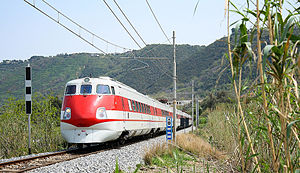History
The Pendolino project was started in the 1970s by FIAT Ferroviaria. Development included a number of prototypes, the last of which was the ETR 401. This prototype was followed by the ETR 450 series units. The first train entered service on between Rome and Milan in 1988.
Every train is made up of 9 units. The trains can reach a maximum speed of 280 km/h (174 mph), service top speed was 250 km/h (155 mph). The ETR 450 were in use on the Rome-Bari, Rome-Ancona-Rimini and Genoa-Florence - Rome lines. It was relegated to lower services with the introduction of the next generation of Pendolino trains (ETR 460, ETR 480) and non-tilting high-speed trains (ETR 500).
In 2004, the tilting mechanism was deactivated, due to the end of production of gyroscopic tilting controls (built by British Aerospace) and as a precaution, and top speed was reduced to 200 km/h (124 mph).
From 2015, all trains are out of service.

A tilting train is a train that has a mechanism enabling increased speed on regular rail tracks. As a train rounds a curve at speed, objects inside the train experience centrifugal force. This can cause packages to slide about or seated passengers to feel squashed by the outboard armrest, and standing passengers to lose their balance. Tilting trains are designed to counteract this by tilting the carriages towards the inside of the curve, thus compensating for the g-force. The train may be constructed such that inertial forces cause the tilting, or it may have a computer-controlled powered mechanism.
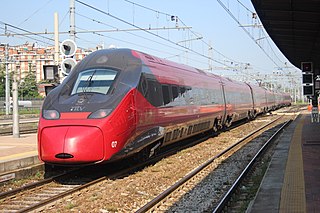
Pendolino is an Italian family of tilting trains used in Italy, Spain, Poland, Portugal, Slovenia, Finland, Russia, the Czech Republic, Slovakia, the UK, Switzerland, China and Greece. Based on the design of the Italian ETR 401, it was further developed and manufactured by Fiat Ferroviaria, which was taken over by Alstom in 2000.

SŽ series 310 is a high-speed tilting EMU used on the InterCitySlovenija premium train service in Slovenia, operated by Slovenske železnice since September 24, 2000. It is based on the Italian ETR 460 commonly known as Pendolino. The train is capable of reaching a maximum speed of 200 km/h. The train is electric single system - 3 kV DC.
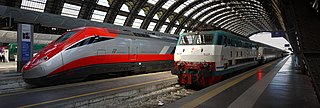
The Italian railway system is one of the most important parts of the infrastructure of Italy, with a total length of 24,227 km (15,054 mi) of which active lines are 16,723 km. The network has recently grown with the construction of the new high-speed rail network. Italy is a member of the International Union of Railways (UIC). The UIC Country Code for Italy is 83.
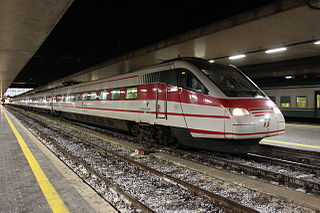
Eurostar Italia was the name given to high-speed trains operated by Trenitalia in Italy. The brand was discontinued and replaced with Le Frecce in December 2012.

Ferrovie dello Stato Italiane S.p.A. is Italy's national state-owned railway holding company that manages transport, infrastructure, real estate services and other services in Italy and other European countries.
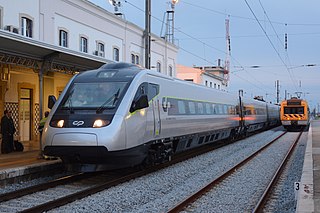
Alfa Pendular is the name of the Pendolino high-speed tilting train of Portuguese state railway company CP. It connects the cities of Guimarães, Braga, Porto, Aveiro, Coimbra, Santarém, Lisbon, Albufeira and Faro, among others at speeds of up to 220 kilometres per hour (137 mph).

The New Pendolino is a class of high-speed tilting trains built by Alstom Ferroviaria for Trenitalia and Cisalpino. It is derived from a model developed for the Chinese operator Changchun Railway Company, and subsequently developed for other railway companies, optionally using the variable weight technology that characterizes this family of trains.
ETR is a series of Italian high-speed trains.

Alstom Ferroviaria S.p.A., former Fiat Ferroviaria S.p.A., is the Italian division of Alstom. Fiat Ferroviaria S.p.A. was the rail division of automobile manufacturer Fiat. It was founded in 1880 as Società Nazionale Officine di Savigliano. Fiat Ferroviaria began building locomotives in the 1930s. It became part of Fiat in 1970. Fiat Ferroviaria acquired the rail business of SIG of Switzerland in 1995, forming the subsidiary Fiat-Sig. The company had previously owned Argentine company Materfer until 1998, which now operates as an independent company.
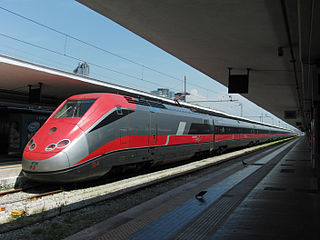
High-speed rail in Italy consists of two lines connecting most of the country's major cities. The first line connects Turin to Salerno via Milan, Bologna, Florence, Rome and Naples, the second runs from Turin to Venice via Milan, and is under construction in parts. Trains are operated with a top speed of 300 km/h (190 mph).

The ETR 200 is an Italian electric multiple unit (EMU) introduced in 1936.

ETR 470 is a high-speed tilting electric multiple unit, which is now only operated by the Greek-Italian private company, Hellenic Train. Introduced in September 1996, nine units were built for the Italo-Swiss firm Cisalpino. They were made by Fiat Ferroviaria, and could tilt up to 8°. Today, there are five trains in Greece.

The Sm3 Pendolino is a class of high-speed body-tilting trains operated by VR Group. It is a member of the Pendolino train family; its design is based on the ETR 460. The first two trainsets were assembled in Finland by Rautaruukki-Transtech in the mid-1990s. The rest of the series of eighteen EMUs were built by Fiat Ferroviaria between 2000 and 2006. The trains serve most of Finland's major cities such as Helsinki, Turku, Oulu and Joensuu with a maximum speed of 220 km/h (140 mph), although this speed is only attained between Kerava and Lahti. The train has a power output of 4,000 kW (5,400 hp) and weighs 328 tonnes.
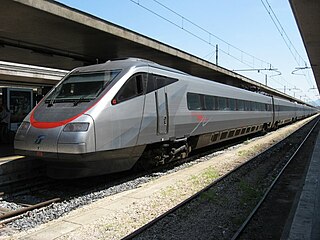
The ETR 480 is a tilting Electric Multiple Unit built by Fiat Ferroviaria since 1993, It is also known as Pendolino. It was developed from the first new-generation Pendolino, the ETR 460. The main difference between ETR 460, ETR 470 and ETR 480 is that the 460 run only on 3 kV DC, the 470 on both 3 kV DC and 15 kV AC, and the 480 on both 3 kV DC and 25 kV 50 Hz AC.

ČD Class 680 are EMUs operating in the Czech Republic, using tilting Pendolino technology intended for the SuperCity train service. Built by Alstom, they were largely based on the nine-car ETR 470. While testing from Břeclav to Brno on November 18, 2004, the Pendolino reached a speed of 237 km/h (147 mph) and created a new Czech railway speed record. The units are able to operate on 25 kV 50 Hz AC, 15 kV 16.7 Hz AC and 3,000 V DC.

The ETR 460 is an electric multiple unit (EMU) tilting train produced by FIAT Ferroviaria since 1993. It is also known as the Pendolino after the family of trains from which it comes.

ETR 500 is a family of Italian high-speed trains built by AnsaldoBreda and introduced in 1993.

The Vesuvio was an express train in Italy, linking Milan and Naples. The train was named after Mount Vesuvius the volcano near Naples.

Frecciargento is a high-speed train of the Italian national train operator, Trenitalia, and a member of the train category Le Frecce. The name, which means "Silver Arrow", was introduced in 2012 after it had previously been known as Eurostar Italia. Frecciargento trains operate at speeds of up to 250 kilometres per hour (155 mph).
